Friday Favorites: Artist Kim Eichler-Messmer
I am inspired by so many things, I decided that every Friday, I will highlight a favorite person, thing, or idea. Maybe you will be inspired too! See all past Friday Favorites here.
<><><><><><><><><><><>
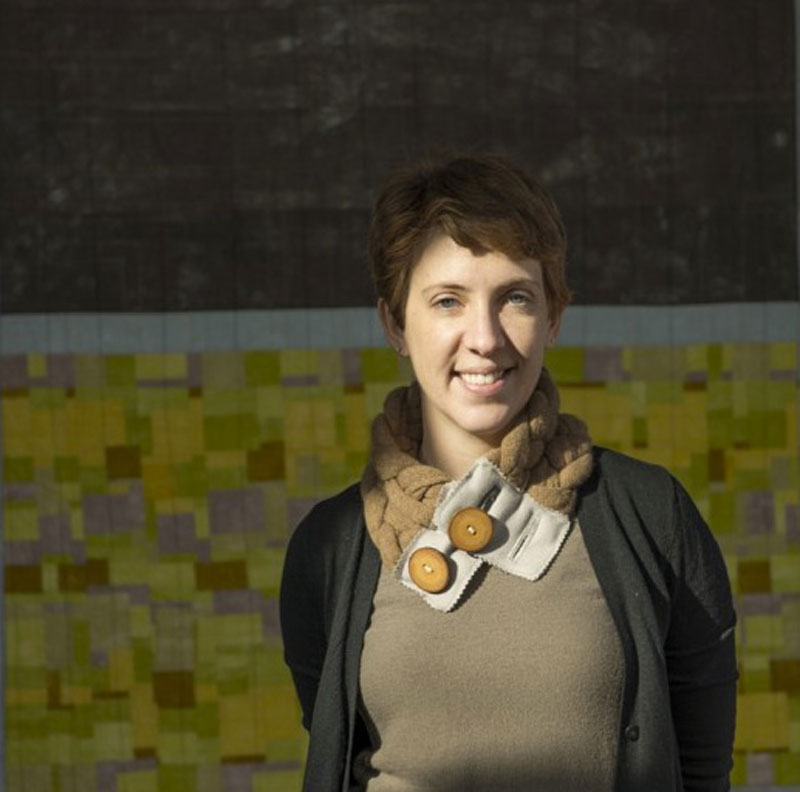
Kim Eichler- Messmer
After I did my very first dye experiment last week, I immediately reached out to Kim Eichler-Messmer, the author of the book I was using, Modern Color. The projects and techniques in the pages of this book are not the tie-dyed, batik fabric you’ve probably seen before. Definitely not. This is a very current feel and approach to the subject of dyeing fabric. Kim is a very talented colorist and quiltmaker, and the projects she presents in the book show a modern side of dyeing. She breaks down the mystery of fabric dyeing and makes it understandable for all of us. I wanted to know more about her work and thought you’d like to as well. Happy Friday!
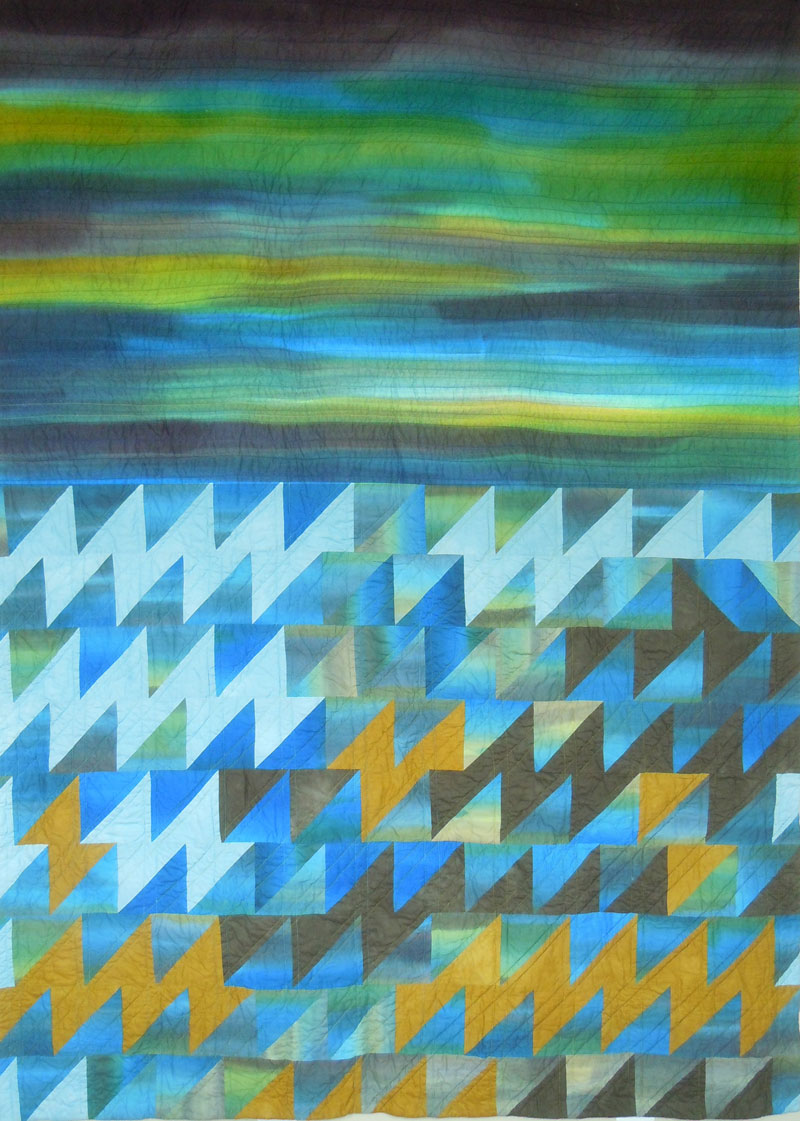
One of Kim’s beautiful landscape quilts.
Blair: Thanks so much for taking the time out for an interview Kim! I bought your book, Modern Color, when I was at Drygoods Design recently, thinking it might be interesting to read about dyeing fabric for modern quilts. But I really had no idea that I would become so inspired! I’d love to hear more about you and your background.
Kim: Thanks for having me! I met Keli from Drygoods last fall at Quilt Market. Her store looks so great. I’m jealous that you can pop in whenever you want!
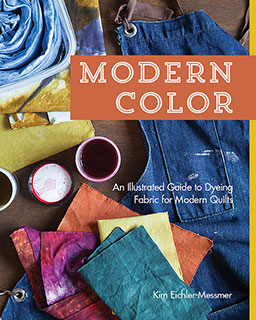
Kim’s book, Modern Color: An Illustrated Guide to Dyeing Fabric for Modern Quilts.
Blair: How did your wonderful book come to be?
Kim: Susanne Woods, who used to be the acquisitions editor for Stash Books at C&T Publishing, contacted me in early 2011 to see if I would be interested in submitting a book proposal. I honestly hadn’t thought about writing a book before then and it kind of freaked me out. The more I thought about it, the more I realized I really wanted to do it. I love teaching, I love quilting, and I love dyeing fabric, so it just seemed like a natural fit that I should write a book about dyeing fabric for quilters. After that it was endless days of writing, editing, dyeing fabric, making quilts, and not a lot of sleep or showering until it was done.
Blair: Do you have a dedicated quilting/sewing space? Is that your dyeing space as well?
Kim: I do have a dedicated space for both quilting and dyeing. In August of 2013 I opened a space called The Kansas City Textile Studio (kctextilestudio.com) that houses my personal studio and also has a small exhibition and workshop space and a separate dye studio. I rent out the space to individuals or groups that want to come in for a day of crafting or dyeing and I frequently have textile related exhibitions and pop-up shops. My studio space is the biggest and nicest I’ve ever had. It has high ceilings, a lot of natural light, and I just got a long arm machine that takes up about half the space.
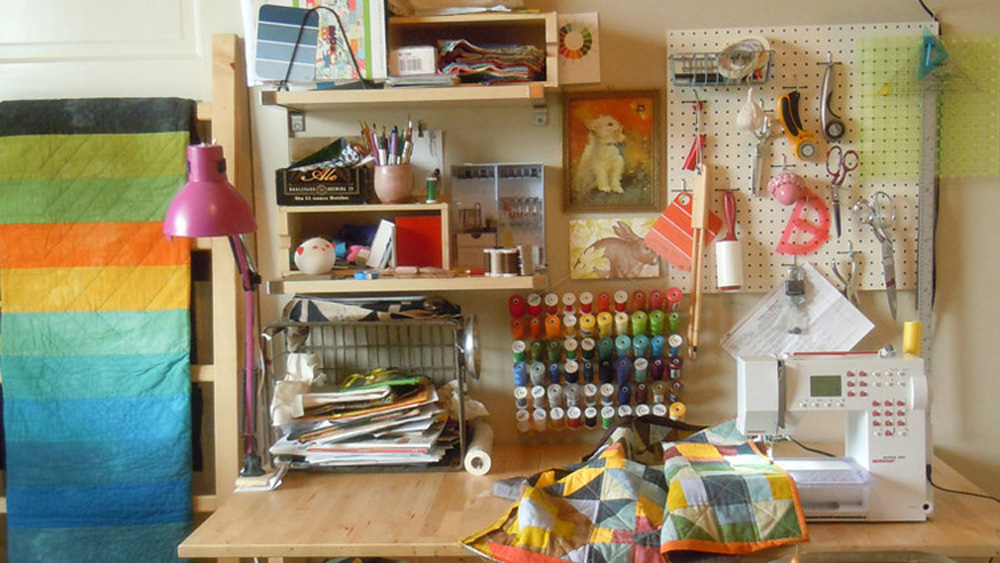
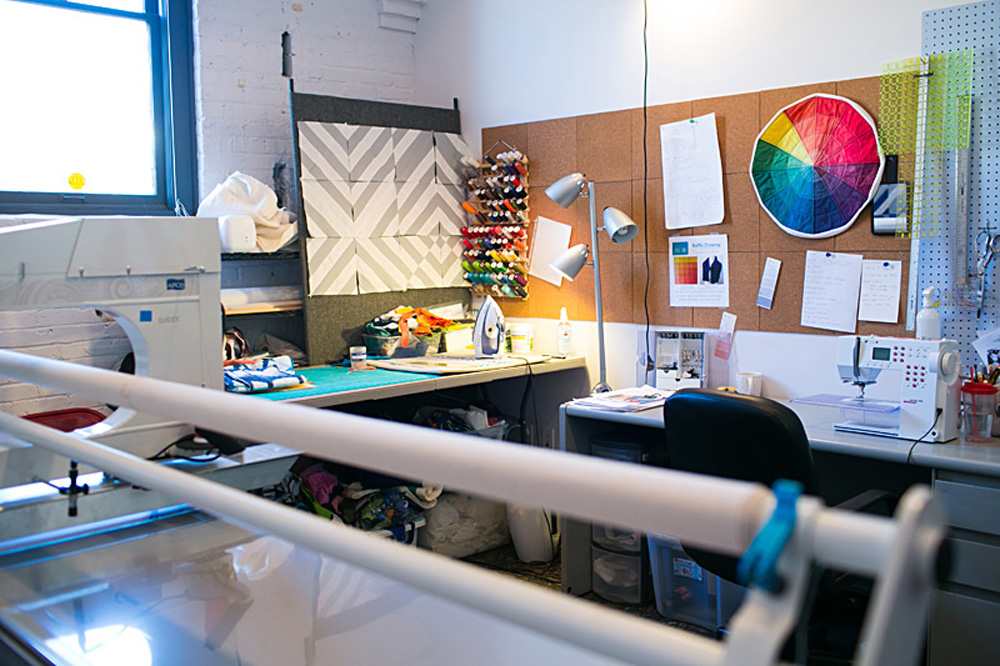
Kim’s studio
Blair: When you dye fabric, do you dedicate a day to dyeing and do several colors, or do you dye just when you need a certain color or feel inspired to experiment?
Kim: When I’m getting ready to start a new project I’ll take a couple of days to dye the fabric I think I’m going to need. I like to plan things so I don’t waste time or materials, so I try to dye just enough fabric to cover whatever quilt I’m about to start. Right now I’m working on some new quilt ideas and trying to paint dye on fabric to look like skies, so I’m spending a lot more time experimenting than I normally would.
Blair: I know for me, dyeing my own fabric was scary to think about, especially using things I’d never heard of, like “soda ash”. After trying my first dye project from your book I found that, even though it takes a little effort, it’s really not that scary! What words of encouragement can you offer non-dyers out there who might be interested in trying it?
Kim: You’re right; it’s not that scary! The projects at the beginning of the book have dye methods that are really fun and easy. For beginners, I suggest reading through the basic dye instructions and supply list first so you know what to buy and how to be safe. Then check out either the dip-dyed place mats or the mottled color quilted tablet case for a good beginner project. Invite a friend over and try it together. As long as you get the basic ingredients in the dye bath – the dye, soda ash, water, and fabric – you will make something great. When I teach workshops, I have my students dye things in fat quarter amounts. You can dye up a bunch of fat quarters pretty quickly and not have to worry about using a lot of fabric or dye.
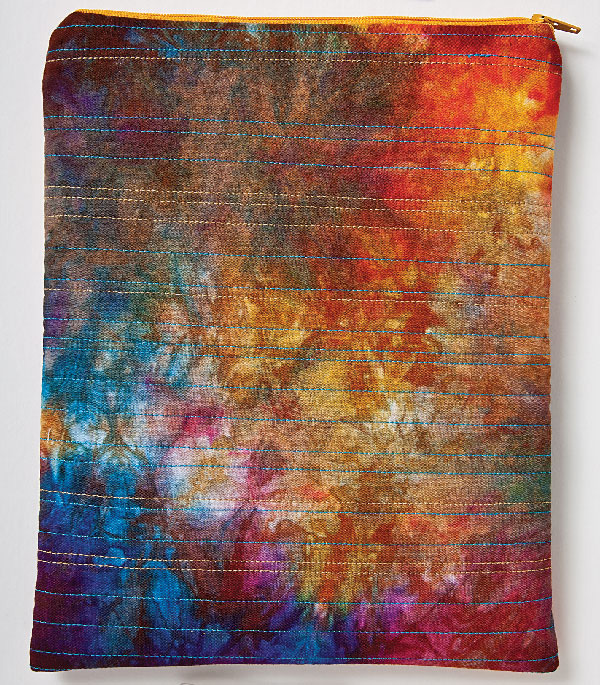
Mottled quilted project in Modern Color
Blair: And quilting! One of my favorite subjects! I’m curious, when I look at your quilts, I wonder if the inspiration for the design comes first? Or, do you get inspiration from the fabrics you dye first? Walk us through the evolution of an idea for you.
Kim: The design always comes first for me. The quilts in the book were mostly inspired by traditional quilt patterns that I thought would be really beautiful if they were simpilified a bit and updated with some clean color palettes and hand dyed fabrics. For those, I started by doing sketches of the quilts in Adobe Illustrator so I could figure out my color palettes before I started dyeing the fabric. I also make quilts that are inspired by landscapes and the sky. For those quilts, I start with my own photographs and start dyeing and piecing to represent the feel of the place in the photograph. My approach in the landscape quilts is a lot more improvisational and I will often over-dye things after they’re pieced if the colors or design aren’t working for me.
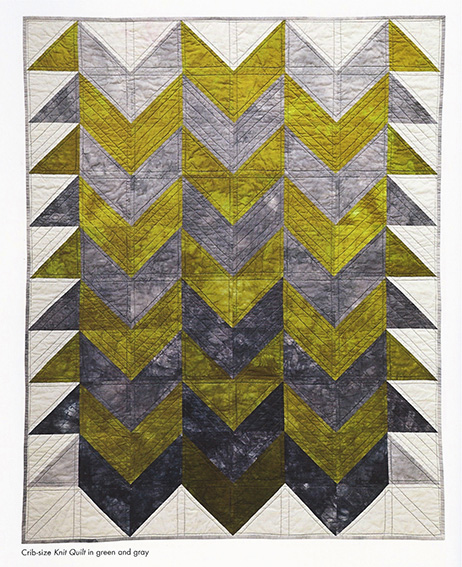
Kim’s Knit Quilt in Modern Color.
Blair: Part of what I love about your work is the beautiful color gradations you create. The Pineapple Quilt (pictured below) in your book is one of my favorite examples, I just love the effect of the gradual deepening of the yellows. It seems very complex, can you talk a little about how you achieve that effect?
Kim: Gradations are my favorite. They seem really complicated, but they’re really not. They’re fun to do and you can create a huge variety of colors in just a few steps. Each step of the gradation is dyed in a separate dye bath, so it’s a lot easier than a true ombre dye where the gradation exists on one solid piece of fabric. Gradation dyeing in a nutshell is taking a certain amount of dye and divvying it up between different dye baths in increasing amounts. So, for example dye bath #1 would have a little bit of dye, dye bath #2 would have a little more, and so on until the last dye bath that would have the most dye. My book has instructions for three different types of gradation – monochromatic (like the pineapple quilt), two-color (gradating from one color to another), and a color overlay gradation (starting with a base color other than white and adding increasing amounts of a second color).
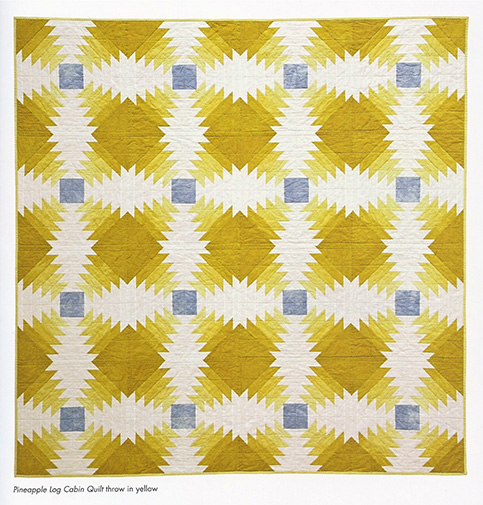
Kim’s Pineapple Quilt in Modern Color.
Blair: Do you currently teach dyeing and quilting? Can we take a class from you?
Kim: Yes to both! I am an Assistant Professor in the Fiber department at the Kansas City Art Institute where I teach Surface Design, Quilting, and Entrepreneurship for Artists. I also regularly teach workshops both at my studio in Kansas City and around the country. At my studio I teach beginning dyeing and beginning shibori about every other month. I have also taught a variety of workshops at Arrowmont School of Arts and Crafts including Introduction to Modern Quilting, Screen Printing on Fabric, and Introduction to Surface Design. And I’m open to traveling to teach other places.
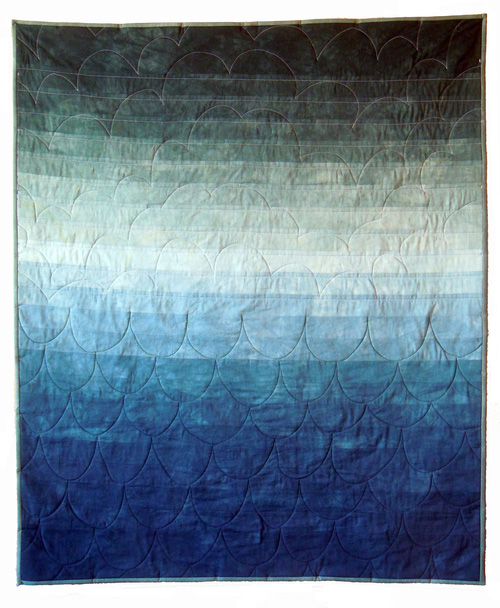
Another of Kim’s landscape quilts.
Blair: I read that you recently worked with Pottery Barn Teen, can you briefly describe how that collaboration came about?
Kim: That was a fun project. They contacted me to see if I would be willing to design a custom landscape quilt for them to manufacture for their boys summer line that had a “Hawaiian surfer” aesthetic. I did a couple of different sketches and sent them a sample version of the design that they sent on to their manufacturer to be made into twin size and full size quilts and shams. It was really exciting for me to see the final product and to see how they styled it.
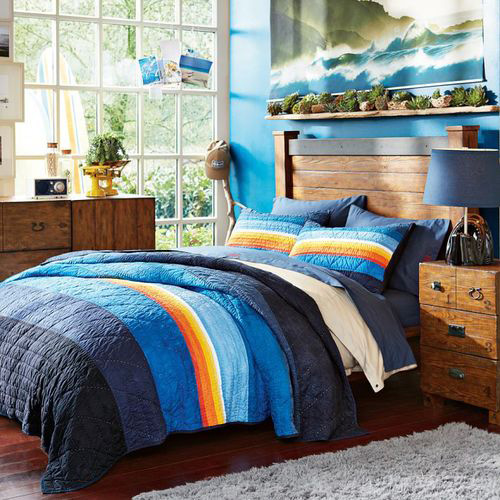
The quilt Kim designed for Pottery Barn Teen.
Blair: What’s next for you? What are your goals for 2014 and beyond?
Kim: I have a gallery show coming up in August and so right now my big goal is to make all new landscape quilts for that. I’m also working on a new line of functional quilts and writing quilt patterns. My biggest goal for 2014 and beyond is to be happy, healthy, and productive!
Blair: And, last but not least, tell us how you like to relax.
Kim: Now that it’s getting warmer, I love to relax by taking long walks or working in my garden. In the colder months I snuggle up with my cats and a book and a nice cup of tea. When I’m not indulging in the crazy cat lady quilter stereotype, I like to drink beer and watch scary movies. Thank you so much Kim! You can find Kim on the interwebs here, Facebook, Instagram, and her book, Modern Color, available here.
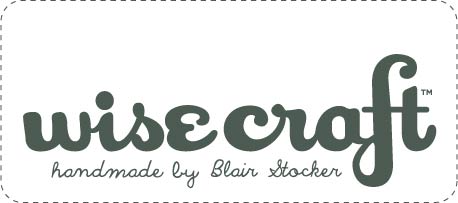
betz
March 21, 2014 at 5:25 amLove this, Blair! This is coincidental. Last week I saw Kim’s quilt on Pinterest (maybe it was your pin?)
https://www.etsy.com/listing/68649601/color-block-quilt-40-x-50?ref=shop_home_active_7
and it reminded me of a photography series my brother did with exposing photographic paper to light:
http://www.pinterest.com/pin/17170042303737104/
I had told him a while ago that I should make a quilt of one of his pieces with Kona solids, but I like Kim’s work better!
erin
March 21, 2014 at 7:00 ami love when you interview new-to-me artists. thanks for introducing me to Kim – i’m excited to learn more about her work!
Sarah
March 21, 2014 at 7:38 amWhat a great interview! I love Kim’s work. Thanks to you both!
Shea Henderson
March 22, 2014 at 8:09 amWe are so incredibly fortunate to have Kim here in Kansas City and now everyone has the chance to learn from her! This was such a great interview and I’m excited to see others hear about her work.